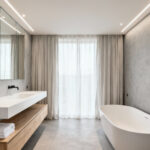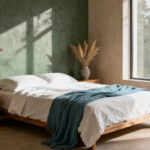In a connected world defined by environmental noise, true wealth isn’t about accumulation. It is defined by the ability to filter out the chaos. We often operate under the assumption that luxury equals abundance—ornate details, bold patterns, and conspicuous displays of status. Yet, this “more is more” approach often creates a visually loud environment that places a constant, low-level strain on our cognitive load.
Instead of serving as a sanctuary, a cluttered space keeps cortisol levels elevated, denying the brain the rest it desperately needs. This is why mastering minimalistic bathroom design is the ultimate expression of “Quiet Luxury.”
“Visual Silence” is a design philosophy that champions the deliberate absence of stimulation as a form of self-care. This mirrors the rising trend of “Stealth Wealth,” where value is communicated through sensory refinement—tactile textures, honed natural stone, and soft, diffused lighting—rather than overt ornamentation. Neuroscience supports this shift, suggesting that environmental silence acts as a mental reset button. It promotes psychological safety and allows the hippocampus to regenerate. Here, negative space is not an empty void; it is an active design element that signals order and spaciousness.
This guide examines how to translate the psychology of “less” into modern bathroom design, transforming a functional room into a restorative haven. We will uncover how to replace visual noise with intentionality, utilizing hidden storage and timeless materials to prioritize mental clarity. By mastering the art of reduction, we create environments that offer the rarest commodity of all: peace. For more comprehensive resources on achieving restorative spaces, review our curated thoughtful bathroom ideas modern wellness design demands.
Phase 1: The Foundation of Cognitive Rest
Think of your bathroom not merely as a utility space, but as an “Attention Restoration Chamber.” In the field of neuroaesthetics, we examine how the brain physically responds to its environment. The verdict is clear: modern life saturates our working memory with visual complexity. This creates “cognitive load,” a subtle but constant mental fatigue.
When you enter a room filled with patterned tiles, visible hardware, and cluttered countertops, your brain subconsciously burns energy trying to categorize that visual noise.

Phase 1 focuses on drastically reducing extrinsic cognitive load. This begins with the strategic use of negative space. In wellness architecture, an empty wall or clear vanity isn’t a void; it is a deliberate “visual pause.” By maintaining clear sightlines and utilizing seamless materials—such as large-format tiles that mimic the continuity of concrete—we tap into the brain’s primitive desire for safety. When the eye can travel unimpeded, the body’s “fight-or-flight” system stands down, signaling that the environment is orderly and secure.
Cognitive rest requires comfort, not sterility. We regulate the nervous system by balancing this visual silence with tactile warmth. Introducing elements like raw wood grains, matte finishes, or the organic weave of a linen towel prevents the space from feeling cold. Combined with recessed, warm lighting that is felt rather than seen, the room stops demanding your attention and starts supporting your recovery. By hiding the “architecture of choice”—tucking away amenities and simplifying fixtures—we allow the mind to finally exhale.
1. The Art of Negative Space: Prioritizing layout over accumulation to lower cortisol levels
When we walk into a cluttered bathroom, our bodies often react before our minds do. Research confirms that the human brain, serving as a constant pattern-recognition engine, interprets visual clutter as a series of unfinished tasks. Studies, such as those from the UCLA Center on Everyday Lives of Families, have linked high densities of household objects directly to elevated cortisol levels. A vanity crowded with products isn’t just untidy; it is a source of cognitive overload that keeps the nervous system in a state of low-grade chronic stress.
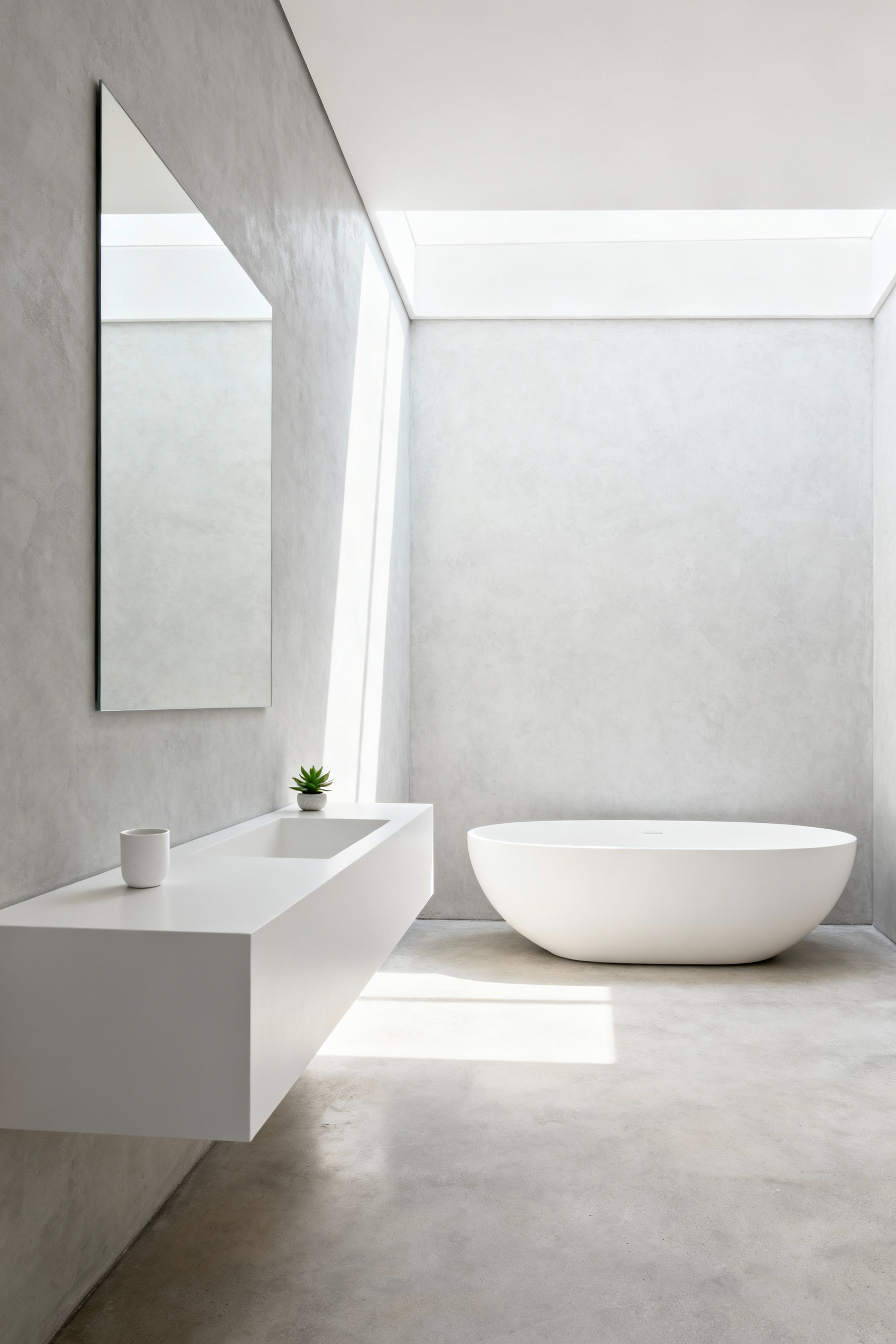
To counter this physiological tax, look beyond simple organization to the structural art of negative space. This approach channels the Japanese principle of *Ma*, or the “meaningful pause.” Unlike the Western tendency to fill every corner, *Ma* treats the empty space between objects as a valuable design element in itself. By prioritizing layout over accumulation, we create a sensory “gap” that allows the mind to rest. As interior designer Anita Yokota suggests, this negative space is not mere emptiness—it is active restoration.
Achieving this “breathing room effect” relies on specific architectural strategies that maximize visual continuity. For example, installing a floating vanity exposes the floor underneath, tricking the brain into perceiving the room as more expansive. This eliminates the dark boundaries where visual weight accumulates. Similarly, utilizing frameless glass instead of opaque barriers allows the eye to travel uninterrupted across the full dimension of the room. When we strip away these visual stops, the focus shifts to the soothing textures of natural stone or wood, turning the bathroom into a vessel for mindfulness rather than a trigger for anxiety.
2. Floating Architecture: Why wall-mounted vanities create a sense of breath and flow
In the realm of wellness architecture, we often analyze “visual weight” and how it influences our perception of space. Traditional cabinetry acts as a heavy anchor, creating a hard boundary where the floor ends and the furniture begins. By lifting the vanity off the ground, we effectively remove this obstruction.
This creates an uninterrupted floor plane where the eye can travel freely from wall to wall. It is a subtle architectural illusion, but one that psychologically expands the room’s footprint, making tight quarters feel immediately more expansive.
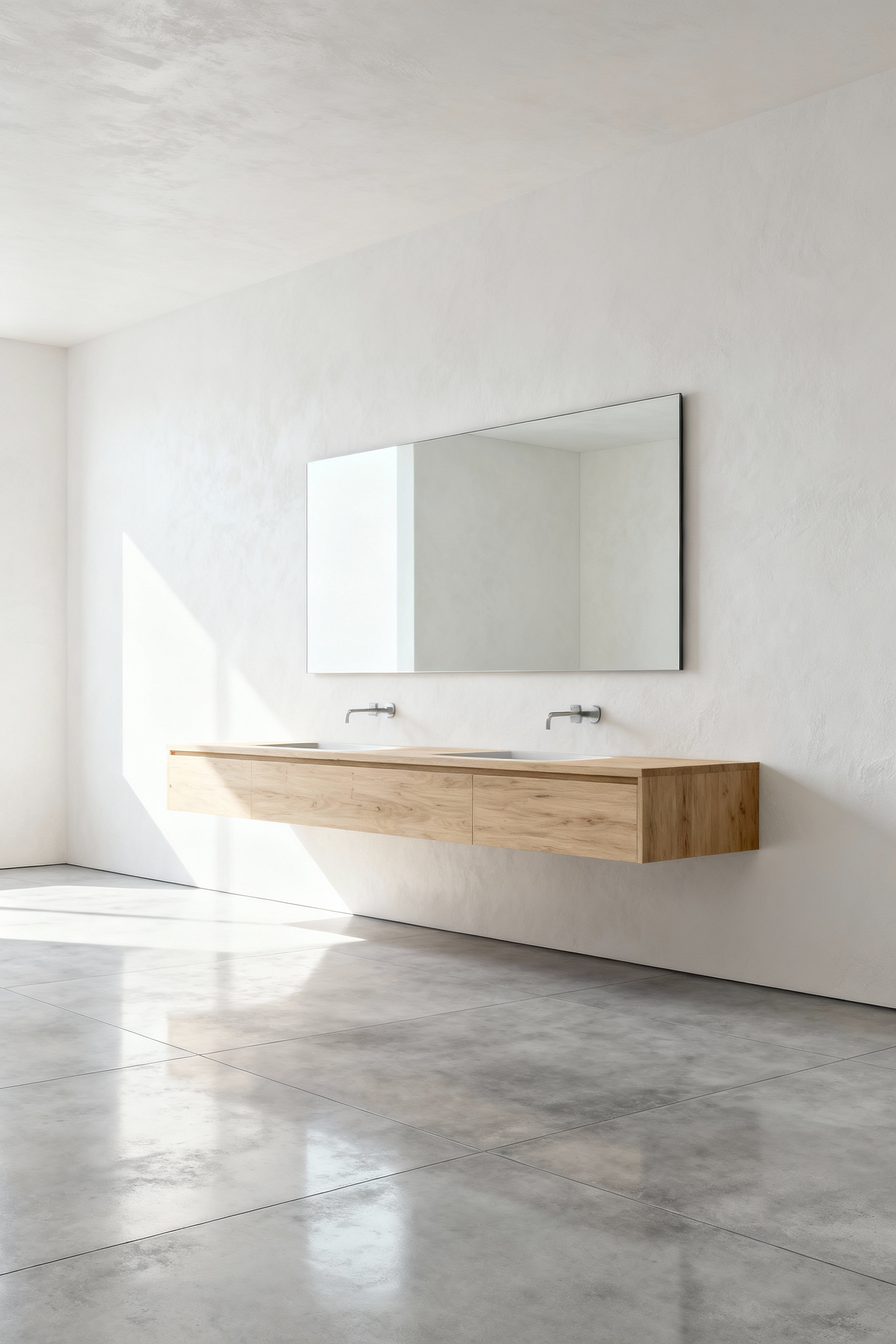
This separation from the floor does more than trick the eye; it fundamentally changes the atmospheric quality of the room. The open gap beneath the cabinetry acts as a channel for light, allowing illumination to bounce into corners that would otherwise remain shadowed. When sunlight or ambient lighting travels underneath the unit, it dispels the boxed-in sensation typical of enclosed bathrooms. You can amplify this airy effect by installing recessed LED strips, casting a soft glow against the floor that turns the vanity into a sculptural, floating element.
Beyond the visual, there is a physical benefit to this design. Removing the bulky base allows for fluid movement, clearing the path for your feet and visually clearing the path for your mind. These fixtures usually favor sleek, handle-less designs that prioritize the texture of wood or stone over ornamentation. The result is a cohesive environment where the furniture feels less like an added appliance and more like a quiet extension of the architecture itself.
3. Hidden Storage Systems: Reducing ‘visual noise’ through integrated cabinetry and recessed niches
Our brains perceive clutter as chaos. In wellness architecture, we identify the accumulation of disparate items—branded bottles, stray brushes, and grooming tools—as “visual noise.” This constant stream of low-level stimuli forces the mind to process unnecessary data, subtly spiking cortisol levels when you should be unwinding. To transform a bathroom into a true sanctuary, we must quiet the room by removing these distractions from your field of vision.
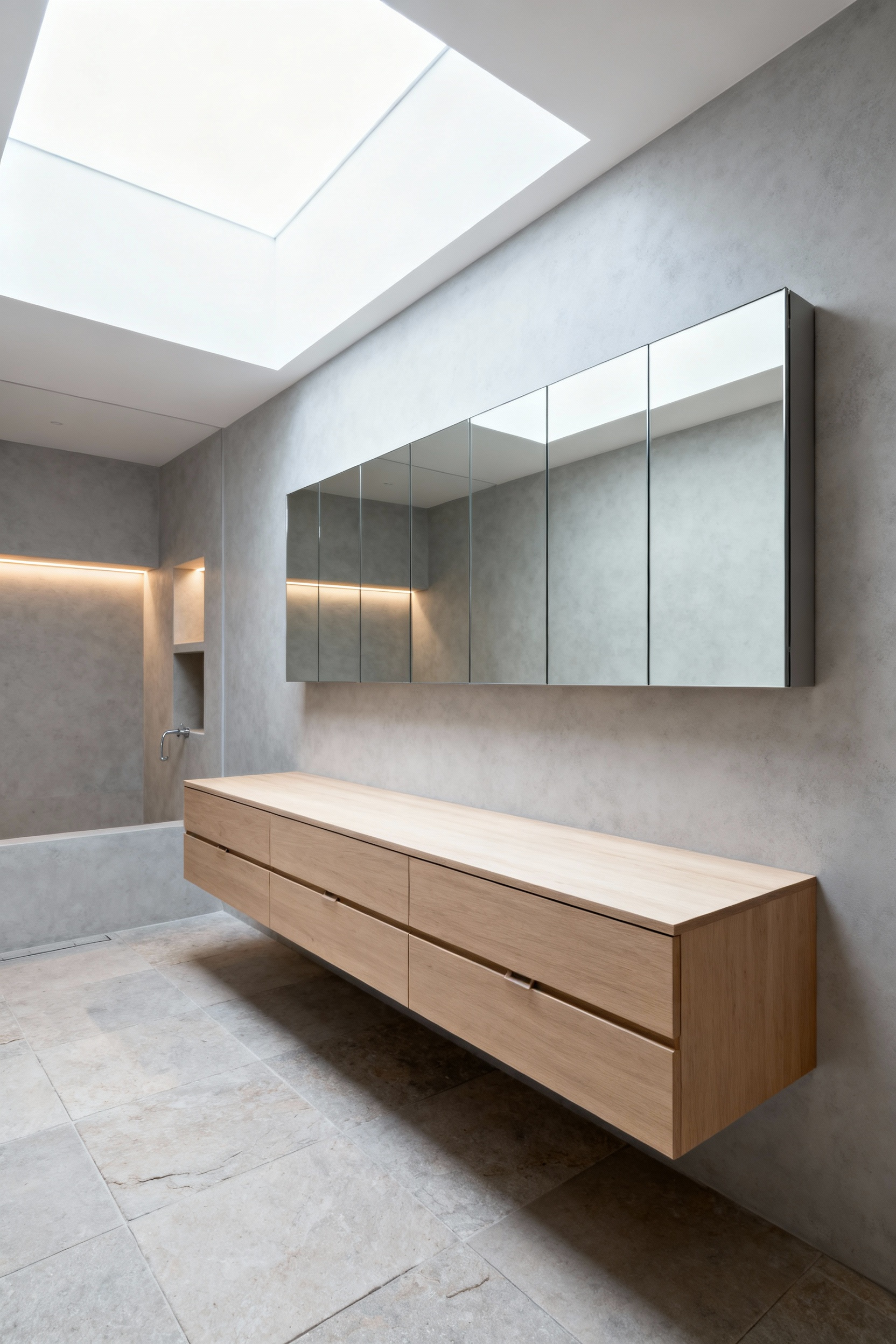
This calming effect is best achieved through integrated cabinetry that acts less like furniture and more like architecture. By utilizing floor-to-ceiling, frameless designs that match the wall color, we create a monolithic plane that effectively disappears. Push-to-open mechanisms eliminate the visual interruption of handles, while soft-close hinges ensure the auditory experience is as soothing as the visual one. The goal is to minimize decision fatigue; if you don’t see it, your brain doesn’t have to manage it.
Inside the shower, the strategy shifts to recessed niches. These maximize the empty cavity between wall studs, creating storage without intruding on the bathing space. Physics dictates design here; standard residential framing typically limits these niches to a depth of 3.5 inches. This technical constraint inadvertently supports a minimalist lifestyle, as the shallow depth forces you to curate only your absolute essentials. To maintain that seamless aesthetic, the niche should be tiled with the exact same material as the surrounding wall.
4. Frameless Glass Boundaries: Removing architectural barriers to promote mental clarity
The frameless glass enclosure serves as a powerful neurological tool rather than a mere aesthetic preference. Traditional heavy hardware, metal tracks, and opaque curtains physically segment a room, forcing the brain to process multiple distinct zones. This visual fragmentation contributes to unnecessary cognitive load.
By stripping away these barriers, we create seamless visual continuity. When the eye can travel uninterrupted across the entire bathroom, it signals “order” to the brain, fostering a profound sense of psychological spaciousness even in modest footprints.
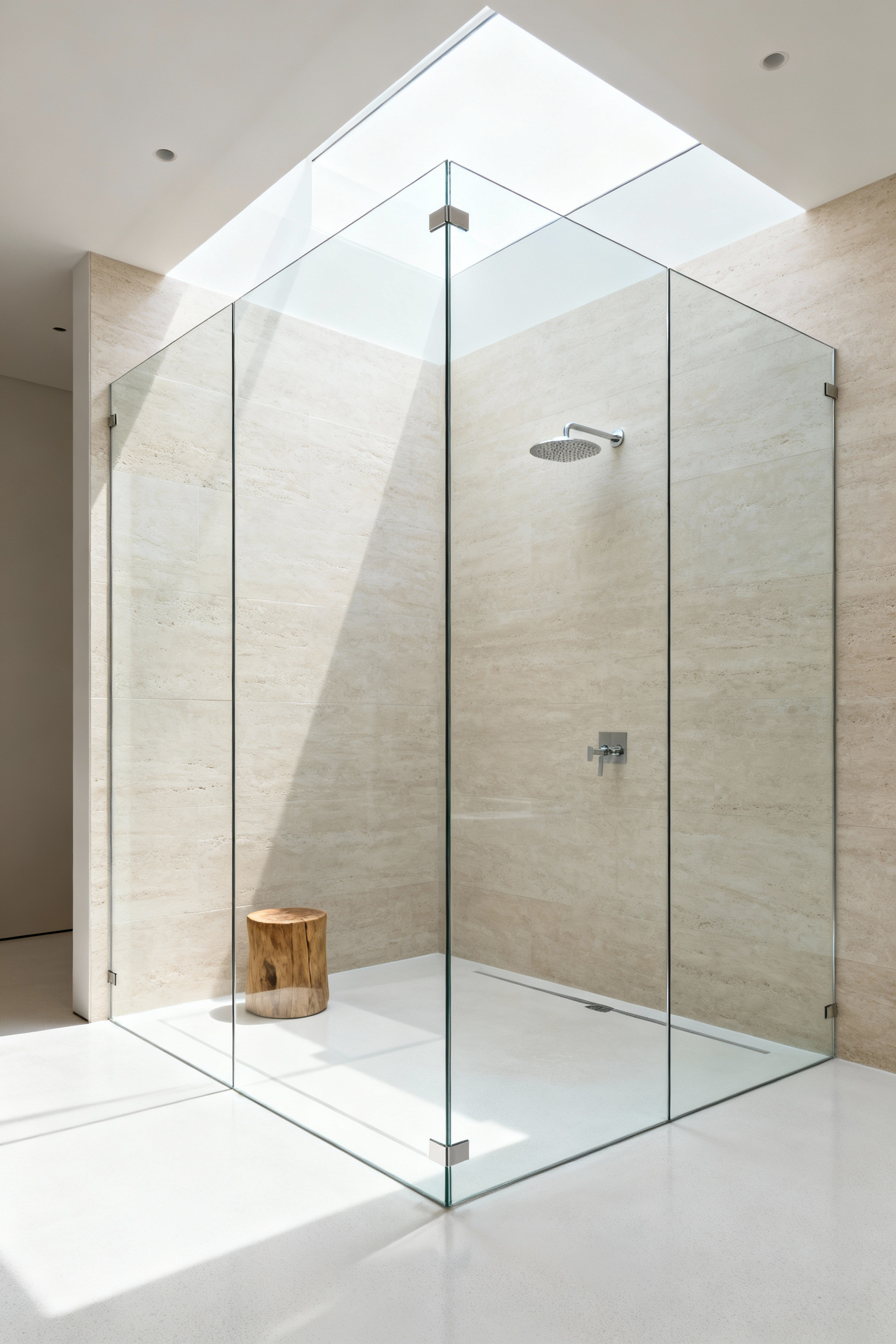
This transparency effectively creates an “invisible” boundary that maximizes the therapeutic potential of light. By allowing natural sunlight to penetrate the showering area without obstruction, the design taps into the biophilic response, helping to boost serotonin levels and stabilize circadian rhythms. The interplay of light against tile and water transforms a daily hygiene routine into a luminous, multi-sensory ritual, elevating the shower from a dark utility space to a restorative vessel.
The benefits extend to the subconscious peace of mind derived from functional purity. Traditional frames and tracks are notorious for trapping moisture and grime, creating hidden clutter that generates low-level maintenance anxiety. Eliminating these nooks simplifies sanitation and minimizes the worry of mold growth. This design often pairs with curbless entries, removing architectural trip hazards to support universal access. The result is a safer, cleaner environment where the mind is free to focus on relaxation rather than vigilance.
Phase 2: Organic Materiality & Touch
While visual silence is mentally soothing, a space defined solely by polished chrome and stark white ceramics can risk feeling emotionally isolating. This maturation of the aesthetic—often termed Organic Modernism—recognizes that true sanctuary requires more than just the absence of clutter; it demands the presence of life. We are essentially fusing the disciplined lines of traditional minimalism with the tactile soul of organic design to mitigate the coldness often associated with industrial styles.

In a room stripped of ornamentation, the texture of the remaining surfaces becomes paramount. This shift prioritizes the *haptic* experience—how a space feels to the touch—over purely visual appreciation. The magic lies in the deliberate tension between the sleek, cool surfaces of modernism and the inherent warmth of nature. Consider the grounding sensation of unpolished limestone or the massage-like tactility of river pebble tiles on a shower floor. These gritty, authentic textures provide a sensory anchor that connects you to the earth, contrasting beautifully with the sharp geometry of the architecture.
To further soften the hard lines of tile and glass, we introduce raw, matte woods. A vanity finished in natural oil or a simple teak shower stool highlights the grain, offering psychological warmth that sterile materials cannot replicate. Even secondary elements play a role in this biophilic approach; layering in organic cotton towels or a woven jute rug adds depth without visual noise. By harmonizing these natural elements, the bathroom transcends its utility to become a nurturing, spa-like environment that actively lowers stress levels.
5. The Biophilic Connection: Integrating living walls and potted greenery to filter air and reduce stress
Incorporating living elements into a minimalist bathroom transforms the space from a utilitarian station into a genuine wellness retreat. This approach goes deeper than simple decoration; it is rooted in the Biophilia Hypothesis, which suggests humans have an innate affinity for living systems. Research indicates that even a visual connection to nature within a small indoor space can activate the parasympathetic nervous system, measurably lowering cortisol levels and blood pressure during your daily rituals.

In a design scheme that champions “less is more,” greenery serves as an artful paradox. The organic, unruly texture of a potted plant or living wall provides a dynamic focal point against the spare, clean lines of modern fixtures. A vertical garden is particularly effective here, as it acts as a high-impact solution that consumes no floor space, aligning perfectly with the minimalist directive to reduce clutter.
Functionally, these botanical additions act as sophisticated bio-filters. While the 1989 NASA Clean Air Study is famous for proving plants remove Volatile Organic Compounds (VOCs) like formaldehyde, the nuance lies in the soil. Microorganisms within the potting mix break down airborne pollutants often found in cleaning products and synthetic materials. To harness this in a high-humidity, low-light bathroom, select resilient species like the Snake Plant (*Sansevieria*) or Peace Lily (*Spathiphyllum*). These varieties not only thrive on the moisture generated by your shower but actively target toxins like ammonia, creating a self-sustaining ecosystem that purifies the air while you unwind.
6. Tactile Stone Surfaces: Using honed marble or slate to ground the body via texture
In the pursuit of visual silence, minimalistic bathrooms run the risk of feeling sterile. The antidote lies not in adding decoration, but in manipulating texture. I frequently specify honed marble for this very reason; by grinding the stone to a smooth, matte finish, we eliminate the high-gloss reflection typical of luxury spaces. Instead of bouncing glare, a honed finish absorbs and scatters light, creating a “velvet” appearance that feels visually soft and psychologically calming. This invites the eye to rest, turning a hard material into something that implies warmth.

True grounding requires physical stability. A honed finish offers essential friction, turning the floor into a safer, slip-resistant surface compared to polished stone. This tactile security is vital; knowing you have a steady grip underfoot allows the nervous system to relax, reinforcing the idea that the space is meant to be lived in, not just admired. It is material honesty at its finest—stone prepared for bare feet and daily rituals.
For a more elemental connection, slate provides a powerful alternative. Its natural cleft and dark, monolithic tones—ranging from deep charcoal to pewter—act as a visual anchor. This weightiness creates a striking contrast in a light-filled room, effectively “grounding” the overall design scheme. As a non-porous, durable material, slate also aligns perfectly with the low-maintenance philosophy of minimalism.
7. Warm Wood Accents: Softening the sterile ‘hospital look’ with teak or walnut elements
While the crisp lines of porcelain and chrome define the minimalist aesthetic, an overabundance of these hard, white surfaces can inadvertently trigger a sense of clinical sterility. The most effective antidote to this “hospital look” lies in the principles of biophilia. Introducing organic textures doesn’t just warm the visual palette; it creates a physiological reset. Research suggests that visual exposure to natural wood grain can lower the activation of the sympathetic nervous system, helping to reduce blood pressure and creating a genuinely restorative atmosphere.

To achieve this balance without sacrificing durability, material selection is paramount. Teak serves as the functional champion for wet environments. Rooted in a long history of shipbuilding, its exceptionally high concentration of natural oils and resins creates a built-in water repellent. This allows the wood to withstand humidity without warping, eventually weathering to a sophisticated silvery-gray that embodies the wabi-sabi appreciation for graceful aging.
For areas further from direct water contact, such as floating vanities or open shelving, walnut offers a rich, grounding counterpoint to bright tiling. The goal of “Organic Modern” is restraint and finish. Avoid high-gloss lacquers that feel synthetic; instead, opt for matte, oiled finishes that allow the tactile quality of the grain to remain the hero. By placing a raw timber element against polished marble or smooth tile, you create a sensory rhythm that transforms a stark room into a layered sanctuary.
8. Seamless Microcement Flooring: Eliminating grout lines for a continuous, calming visual plane
Traditional tiling inherently creates a grid, forcing the eye to unconsciously register thousands of stops and starts. By replacing that interruption with microcement, we eliminate visual noise to foster a sense of genuine tranquility. This unbroken plane allows the gaze to travel freely across the room, which is particularly effective in smaller bathrooms. The continuous surface tricks the brain into perceiving a single, expansive area rather than a segmented box.
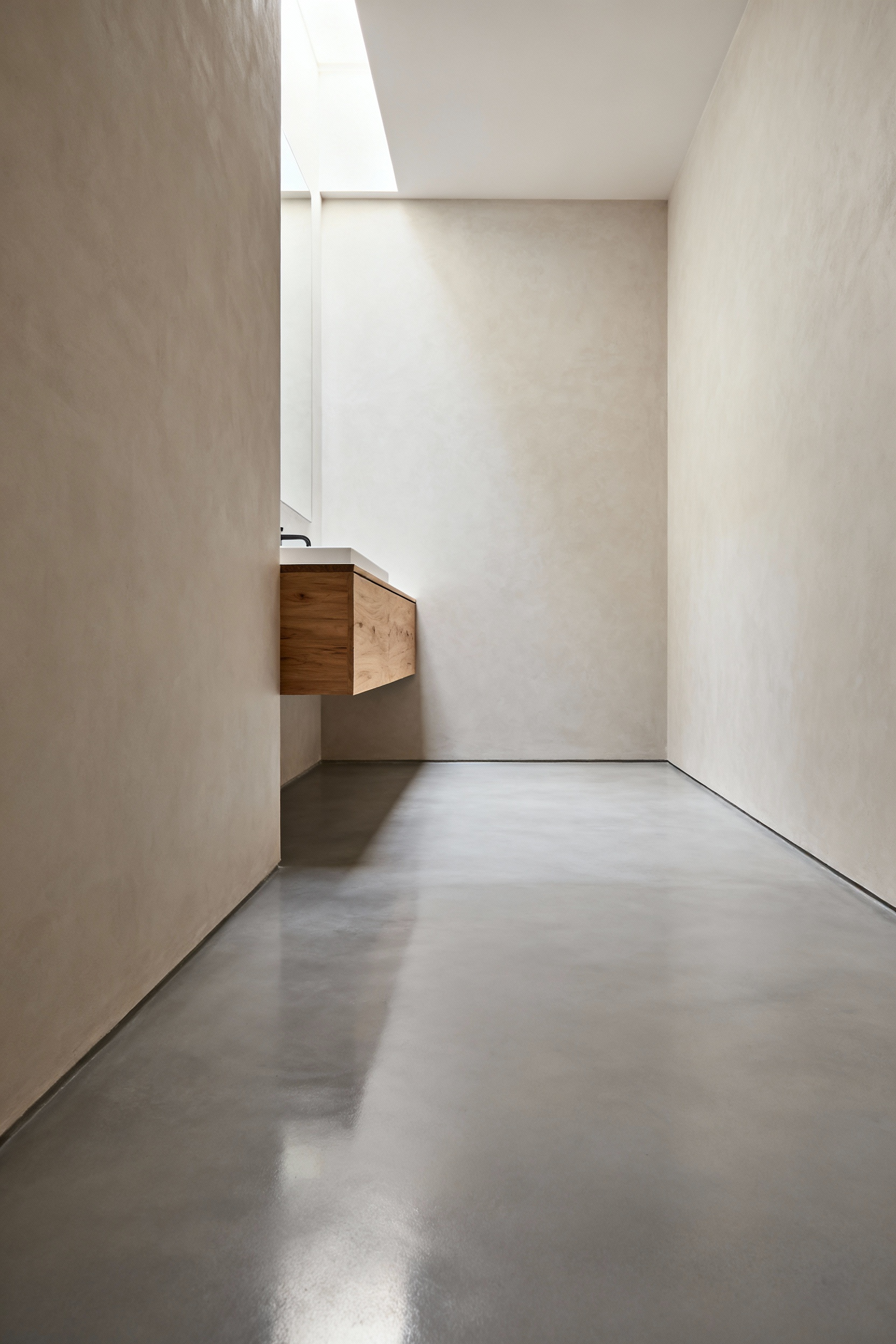
This material allows for a seamless approach to cohesion. Because microcement is applied in thin layers of just 2-4mm, it can wrap up walls, flow into shower enclosures, and coat custom vanities to create a monolithic envelope. This blurs the lines between horizontal and vertical surfaces, turning the bathroom into a unified, waterproof sculpture rather than a collection of fixtures.
Despite this sleekness, the finish creates a sensory connection often missing in modern design. Skilled artisans apply the material by hand, leaving behind subtle trowel marks and textural nuances. This organic, mottled effect prevents the minimalism from feeling sterile, offering a tactile depth similar to ancient Moroccan Tadelakt.
Eliminating grout lines also addresses a critical aspect of a healthy home environment. Grout is traditionally the primary harbor for soap residue, mold, and mildew. By removing these crevices, microcement creates a hygienic, waterproof surface that supports better indoor air quality. The result is a space that is physically easier to maintain and mentally easier to exist in, free from the visual clutter of dirt accumulation.
Phase 3: Sensory Calibration
True wellness architecture goes beyond simple decluttering; it requires sensory calibration. This process deliberately strips away the over-stimulating noise of modern life to tune the occupant’s perceptual sensitivity. By refining the environment, we transform a utilitarian bathroom into a low-impact sensory retreat that prioritizes cognitive harmony over visual complexity.

This calibration begins with sight, but not merely for the sake of cleanliness. The goal is to reduce cognitive load so the brain can rest. We achieve this by using large-format tiling, often up to 24×48 inches, to minimize grout lines. Eliminating these small visual interruptions creates a seamless surface flow, acting as a perceptual reset button that allows the eyes—and the mind—to drift effortlessly.
Once the visual noise is quieted, the sense of touch must take over to prevent the space from feeling sterile. In the “Soft Minimal” philosophy, we counter cool porcelain and glass with high-quality, organic textures. A matte stone finish that channels windswept sand or a natural wood vanity introduces essential warmth, ensuring the environment feels human-centric and grounded rather than clinical.
Finally, we tune the invisible architecture of sound and light to bring in the “spa magic.” We replace the harsh splatter of high-pressure jets with the gentle, acoustic trickle of a rainfall showerhead, using water as a form of sound therapy. This is paired with warm, low-level LED strips that wash surfaces in a soft glow rather than flooding the room with brightness. By diffusing light and deepening shadows, we cultivate a mood that elevates a daily routine into a restorative ritual.
9. Circadian-Adaptive Lighting: Smart systems that mimic natural sunlight patterns for better sleep hygiene
Lighting in a wellness-focused bathroom acts as a silent regulator of your body’s internal clock. Deep within the eye, specialized cells known as ipRGCs detect specific wavelengths of blue light to signal the brain’s master clock. In the morning, a vanity illuminated with cool, high-intensity white light (5500K–6500K) does more than help with grooming—it actively suppresses melatonin, boosting alertness and setting your circadian rhythm for the day ahead.
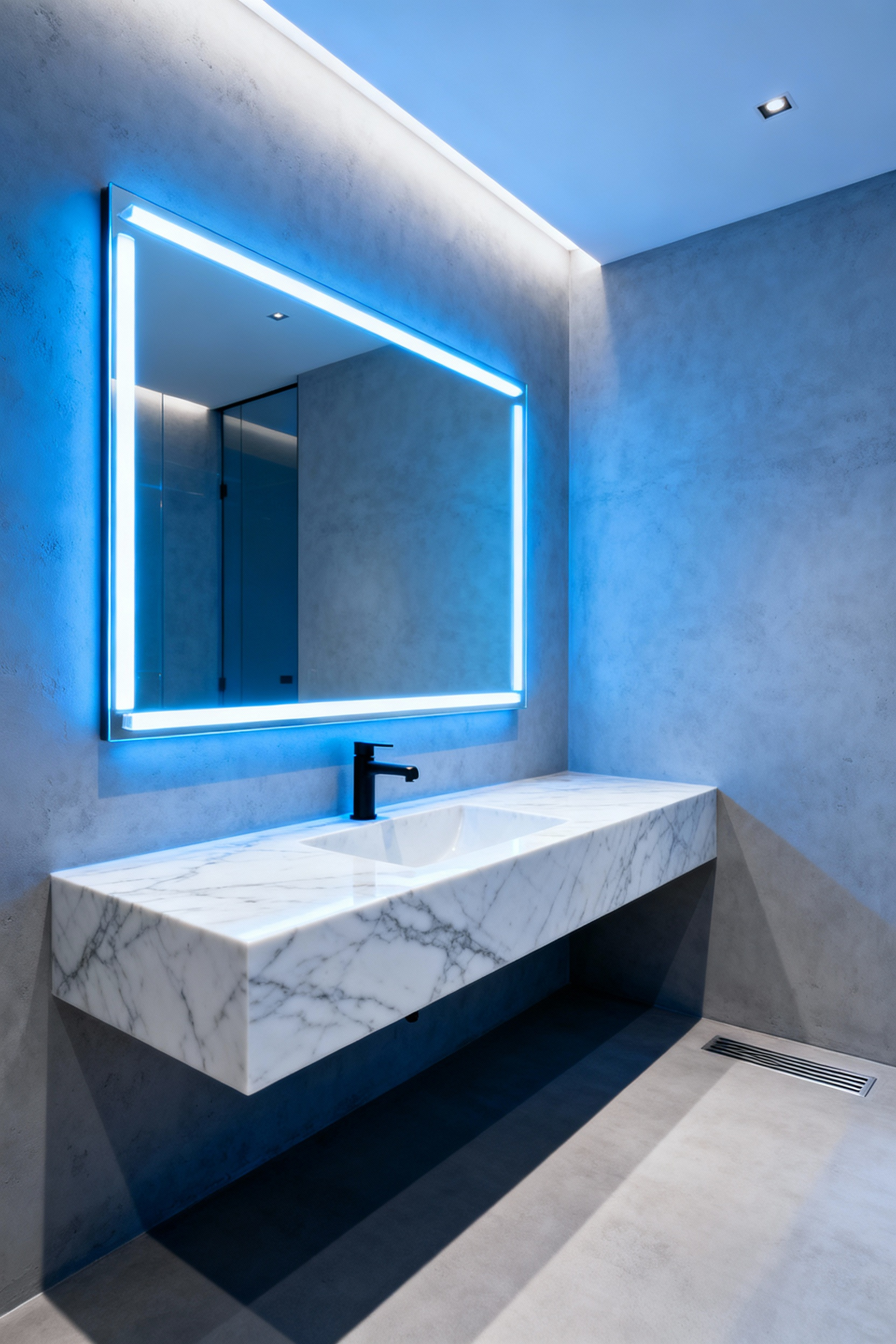
That same cool spectrum becomes detrimental in the evening, potentially delaying sleep onset by over an hour. To counter this, minimalist architecture employs concealed technology where the fixture disappears, leaving only the biological benefit. Frameless mirrors and cove lighting equipped with smart, tunable LEDs can automatically shift to a warm, amber glow as the sun sets. Motion-activated strips beneath a floating vanity provide a soft night-light pathway, allowing for safe navigation without triggering the wakefulness response that disrupts sleep hygiene.
The most sophisticated systems are moving toward hyper-personalization, acknowledging that sensitivity to light varies drastically between individuals. Rather than a generic setting, future iterations will likely sync with personal biometric data, creating a custom light curve that supports your unique physiology. In this way, the bathroom becomes a seamless instrument for health, where the most powerful tool is the light you barely notice.
10. Matte Finish Fixtures: Reducing harsh glares and reflections to soothe the eyes
In a space often defined by high-intensity task lighting and mirrors, the choice of fixture finish is a matter of visual ergonomics. Traditional polished chrome acts much like a mirror, creating “specular reflection”—sharp, directional beams of light that result in uncomfortable glare.
Matte finishes, conversely, possess a micro-textured surface that disrupts this aggressive bounce. Instead of striking the eye directly, light is absorbed and scattered in multiple directions. This diffusion softens the room’s overall illumination, significantly reducing eye strain and cultivating the visual serenity essential for a restorative environment.
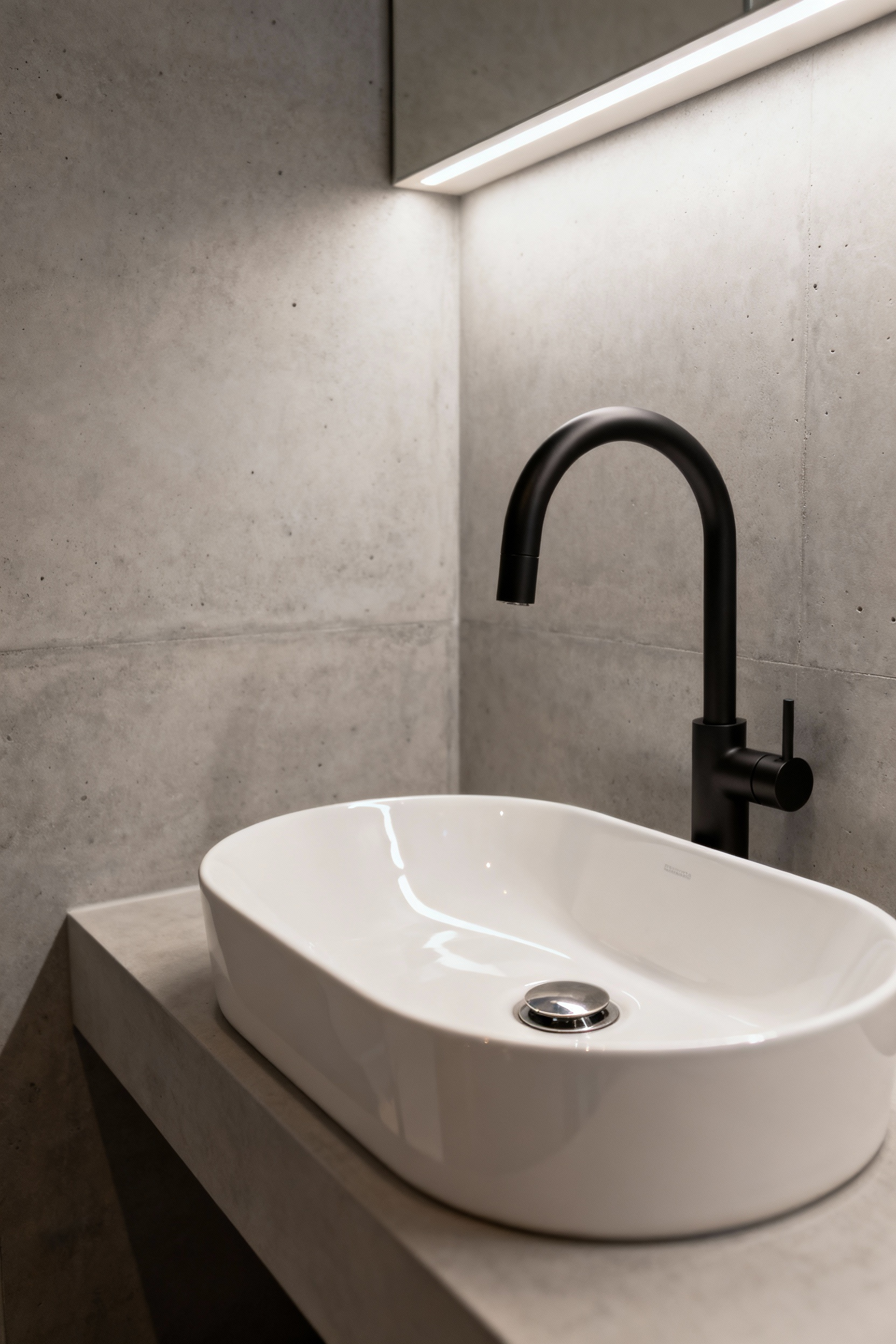
True minimalism seeks to eliminate noise, and nothing disrupts a serene vignette quite like the visual clutter of water spots and fingerprints. High-gloss surfaces tend to highlight these transient messes, turning minor maintenance issues into conspicuous distractions. Matte fixtures offer a subtle, modest appeal that effectively conceals daily imperfections. By receding visually rather than demanding attention with sparkle, they ensure the bathroom’s clean geometry remains the focus.
Beyond their visual quietness, these fixtures introduce a unique, velvety tactility to the bathroom. Because matte black or dark finishes absorb ambient light, they act as a grounding anchor within the design. This intentional lack of reflection allows the organic textures of adjacent materials—such as the grain of oak cabinetry or the complex veining of marble—to appear richer and more distinct. The result is a sophisticated layering of textures that feels grounded, cohesive, and physically soothing.
11. Sound-Dampening Textiles: Selecting high-GSM organic cotton and plush rugs for acoustic softness
Sleek, minimalist aesthetics often create an inadvertent echo chamber. Tile, glass, and porcelain reflect sound, making a dropped comb or a splashing faucet sound harsh and jarring. This is where your choice of textiles transitions from purely functional to architectural.
High-GSM (Grams per Square Meter) organic cotton is the most effective tool here. When you select towels in the 600 to 900 GSM range, you aren’t just choosing luxury; you are introducing a dense, fibrous structure capable of trapping mid-to-high frequency sound waves. A stack of these heavy, sumptuous towels acts as a temporary acoustic damper, visually and audibly softening the room’s hard edges.
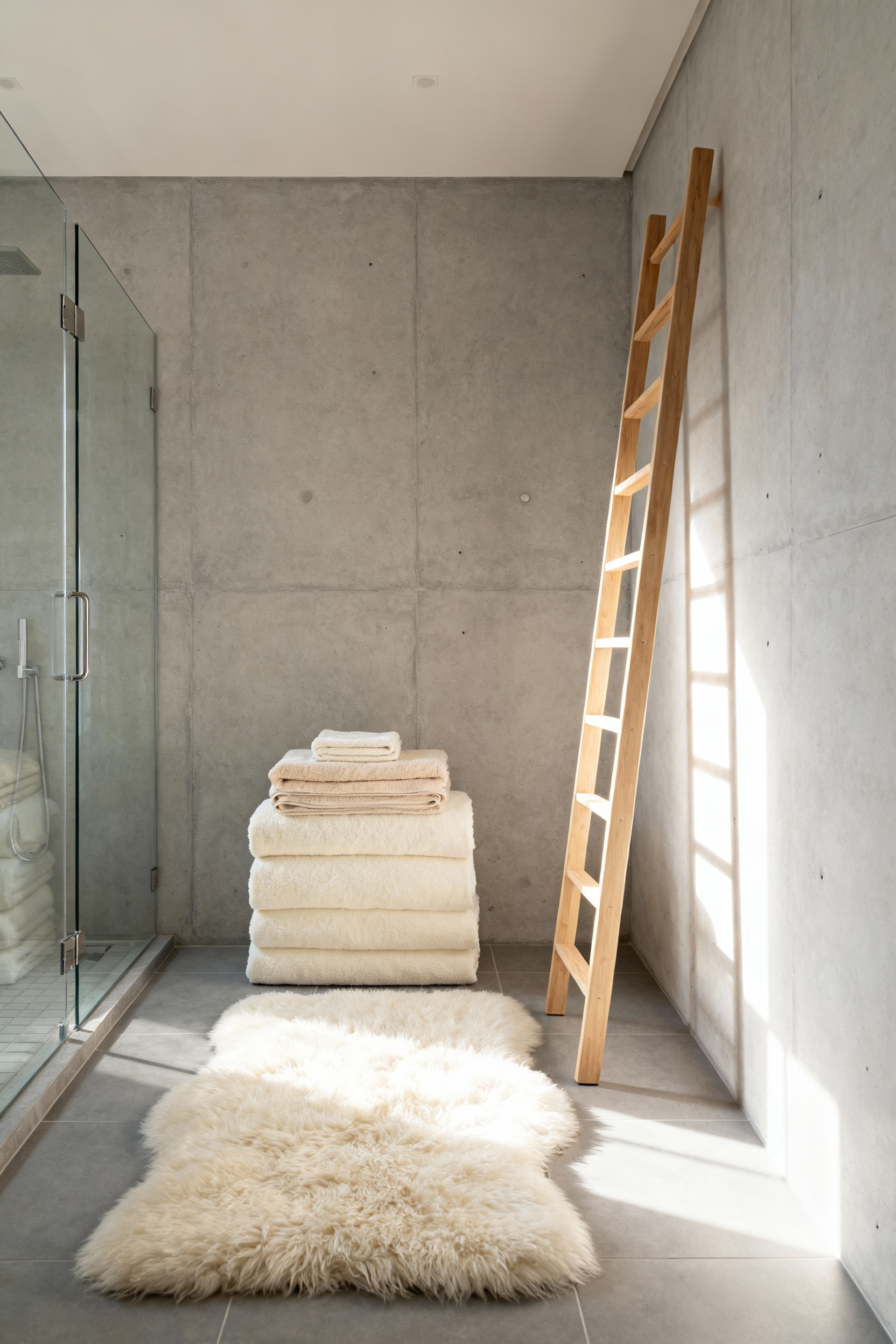
Grounding the space requires addressing the floor, the primary reflector of impact noise. A standard bath mat offers little resistance to sound, but a plush rug with a high pile—specifically between 10mm and 18mm—can fundamentally change the room’s auditory profile. Dense natural fibers like wool are exceptional at deadening the vibration of footsteps, preventing that sharp “clack” against tile from reverberating through the structure. For the best result, layer this with a high-quality rug pad to maximize sound absorption.
Opting for organic materials reinforces this sense of sanctuary by keeping the air free of VOCs, ensuring your retreat remains chemically clean. By treating these textiles as acoustic tools, you transform the bathroom from a sterile washroom into a quiet oasis where the silence is as palpable as the design itself.
12. The Olfactory Dimension: Designing dedicated spaces for aromatherapy and essential oil diffusion
True minimalism isn’t just about what you see; it’s about the invisible architecture of a room. In wellness design, we often treat scent as a structural element rather than an afterthought. The goal is to move beyond the clutter of countertop gadgets toward invisible integration, creating a multi-sensory experience that feels effortless.
The most sophisticated approach involves commercial-grade HVAC scenting systems. By connecting cold-air diffusion technology directly to your home’s ductwork or concealing the unit in a ceiling plenum, fragrance becomes an inherent quality of the air. This dry, waterless method ensures uniform saturation without the humidity or visual noise of traditional misting devices.
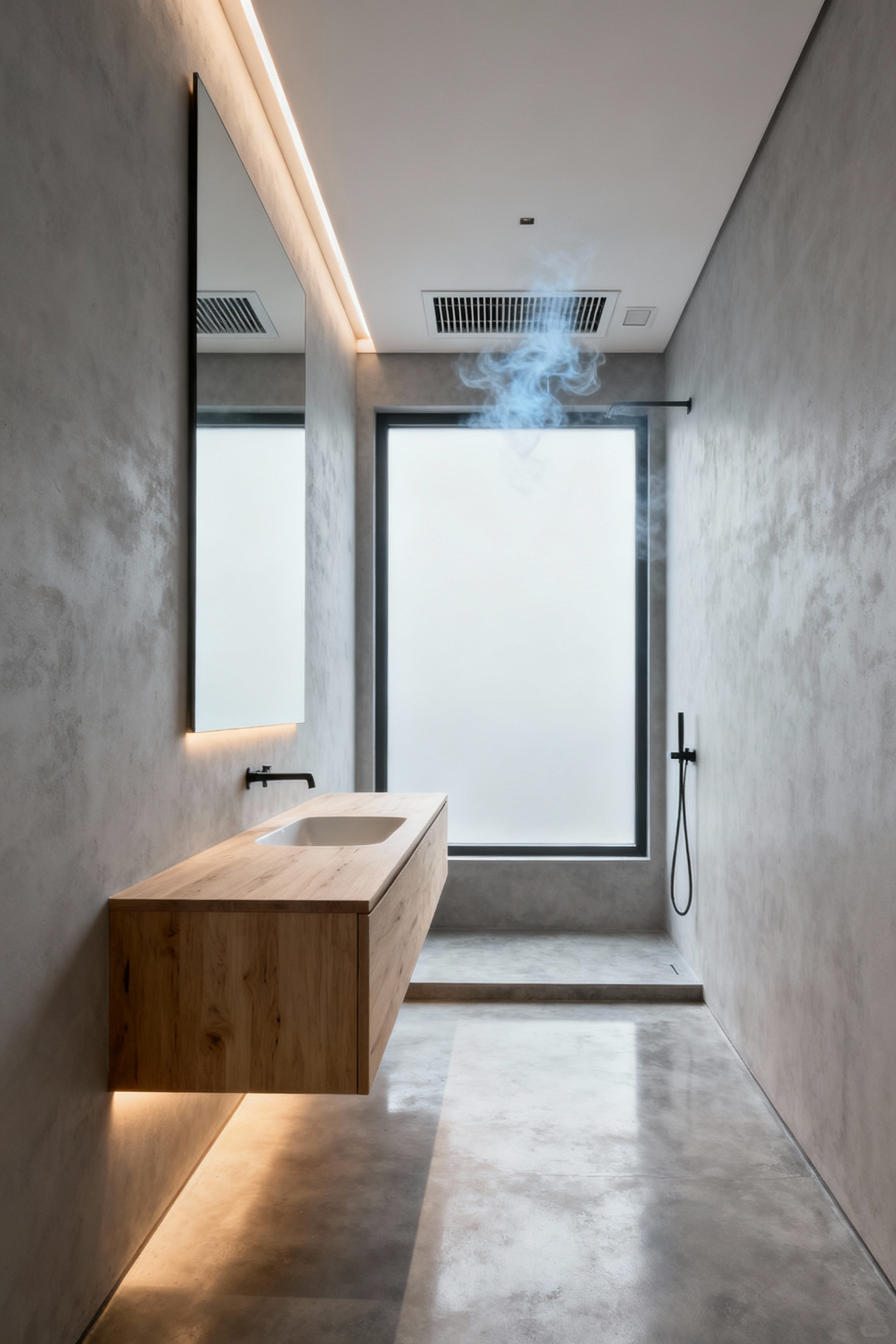
This invisible infrastructure allows for “olfactory chronology,” where the atmosphere shifts to match your biological rhythm. Through app-controlled programming, your bathroom can stimulate alertness in the morning with notes of eucalyptus or rosemary, aiding clear breathing during a steam shower. The system can then automatically transition to calming sandalwood or lavender in the evening, signaling your nervous system to de-stress and prepare for sleep.
If structural integration isn’t feasible, apply a strict protocol of concealment to maintain visual calm. Essential oil collections should reside in custom vanity organizers or push-to-open recessed wall niches, ensuring surfaces remain clear. When a diffuser must be visible, opt for passive diffusion methods using materials like unglazed ceramic, concrete, or porous stone. These elements merge seamlessly with the room’s organic textures, ensuring the object contributes to the serenity of the space rather than detracting from it.
Phase 4: The Ritual of Use
True minimalism does more than simply look clean; it choreographs your daily life, transforming a mindless hygiene routine into a mindful ritual. This concept is where the design’s philosophical promise is effectively realized. When you step up to a vanity completely void of visual clutter, your brain experiences an immediate reduction in cognitive load.
By stripping away the “visual noise” of scattered products and utilizing precise, hidden storage, the space disciplines information. It creates an unbroken surface that allows your attention to turn inward, focusing on self-care rather than managing the chaos of your environment.

In this intentional absence of ornamentation, the materials themselves invite you to be fully present. The design relies on the tactile quality of honest textures: the cool solidity of honed stone, the warmth of water-resistant natural wood, or the smooth resistance of a porcelain basin. These touchpoints anchor you in the physical reality of the moment, elevating a standard habit into a sensory experience.
Lighting acts as the final layer of this choreography. While efficient task lighting supports the precision of grooming, the ability to shift to concealed ambient lighting or a soft accent glow near the tub signals a physiological transition. This change in atmosphere allows the nervous system to downshift from the active day to a restorative evening state. The result is a seamless flow where every movement is anticipated, turning the bathroom into a genuine sanctuary for mental regeneration.
13. The Freestanding Tub: Positioning the bath as a meditative focal point rather than a hygiene utility
The freestanding tub acts as a sculptural monolith in the landscape of minimalist design. By pulling the fixture away from the wall and centering it within a buffer of negative space, we effectively divorce the object from the mundane utility of plumbing. It becomes an altar for relaxation, commanding the room not through clutter, but through isolation.
Where the rest of the minimalist bathroom relies on stark lines and sharp edges, the organic curve of an egg-shaped or oval tub softens the room, inviting the eye to rest before the body follows. When positioned near natural light or a scenic view, this placement blurs the boundary between interior sanctuary and the natural world.

This architectural separation supports a critical physiological shift. Moving the bath to the center of the room changes the narrative from hygiene to *katharsis*, turning a daily habit into a deliberate ritual. Immersion in warm water actively stimulates the parasympathetic nervous system, interrupting the modern fight-or-flight state and signaling safety to the body. The tub acts as a vessel for this stillness, creating a dialogue between body and breath that is difficult to achieve in a standard, recessed enclosure.
To sustain this meditative state, the vessel’s materiality is as vital as its placement. High-quality materials like stone resin or cast iron are preferred over standard acrylic for their superior heat retention. A rapid drop in water temperature is the quickest way to break a meditative trance, so these denser materials are essential for maintaining warmth during a prolonged soak. Combined with ergonomic designs—such as the sloped back of a slipper tub—the physical environment disappears, leaving only the sensation of weightlessness and a quiet, tactile luxury.
14. Digital Detox Zones: Intentionally omitting outlets for screens near relaxation areas
The creation of a digital detox zone is where strict electrical safety mandates and wellness philosophy happily converge. While the National Electrical Code requires a specific buffer zone around bathtubs to prevent shock hazards, a wellness-focused designer views this exclusion as a critical architectural opportunity.
By intentionally omitting outlets within the bathing radius, we transform a safety regulation into a psychological boundary. This deliberate absence removes the visual trigger of a charging port, effectively banning the “always-on” culture from the core of your sanctuary.
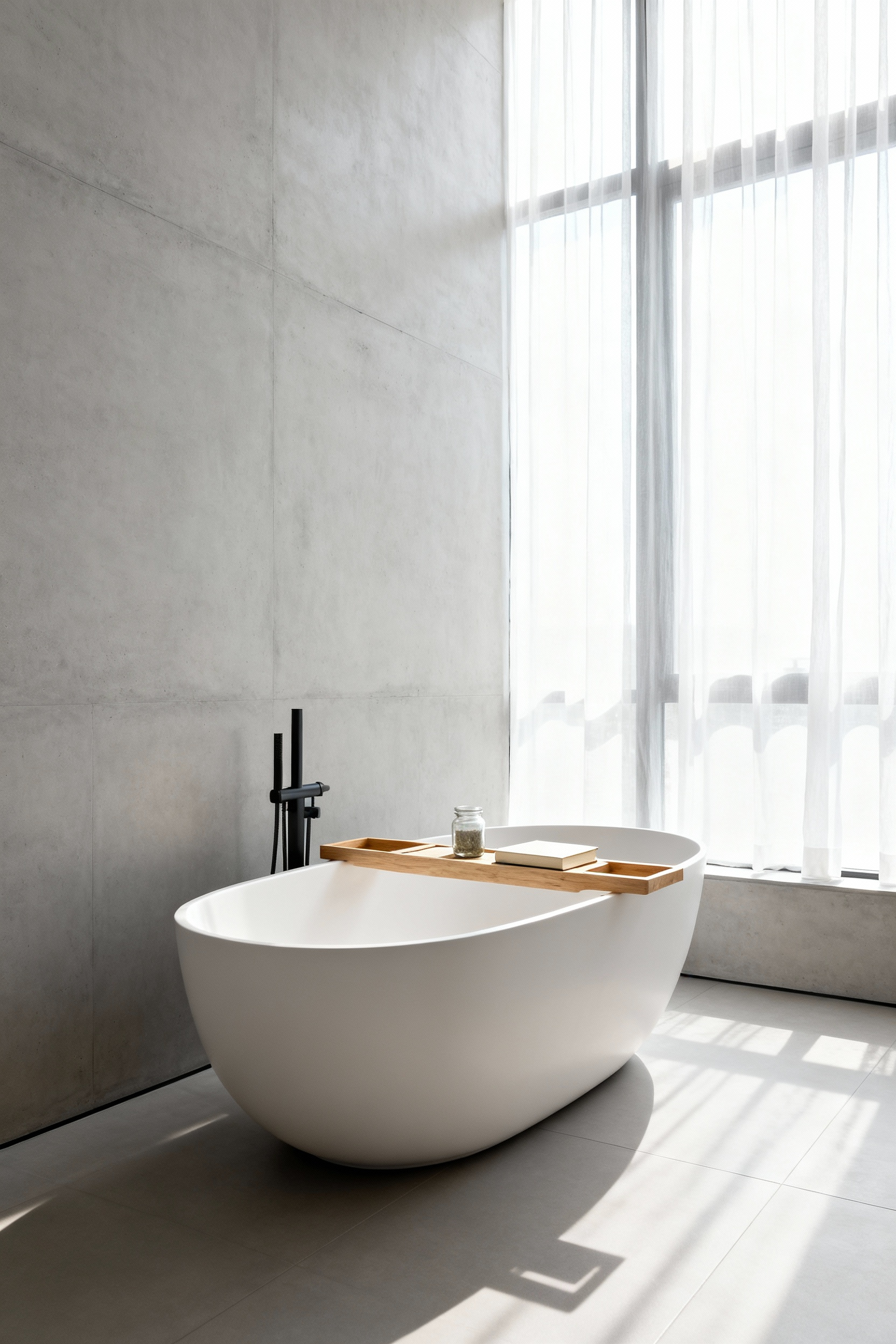
Aesthetically, this omission purifies the visual field. Without the interruption of plastic receptacles, slabs of marble or expanses of handcrafted tile remain unbroken, allowing the eye to rest on the continuous material rather than the utility. This creates a sense of “visual silence” that supports the mental clarity we seek in a spa environment.
Beyond the clean lines, this design choice actively protects your circadian rhythm. Eliminating the temptation to keep devices charged and within reach reduces exposure to stimulating blue light during evening routines. Instead of signaling the brain to stay alert with scrolling, the space invites analogue rituals—reading a physical book, focusing on the texture of warm water, or simply decompressing in soft, ambient light. The bathroom effectively shifts from a functional grooming station to a therapeutic cocoon, prioritizing deep rest over connectivity.
15. Monochromatic Color Theory: Using tone-on-tone palettes to minimize brain processing requirements
A monochromatic bathroom scheme is a calculated tool for mental preservation. When we enter a room filled with high-contrast colors and patterns, our brains instinctively work to separate, identify, and categorize every individual element—the vanity, the distinct tile lines, the textiles. This requires micro-levels of energy that contribute to cognitive load.
By utilizing a tone-on-tone palette, we leverage the Gestalt principle of similarity. Because the brain naturally groups similar hues together, it processes the room as a unified, fluid entity rather than a chaotic collection of parts. This visual coherence lowers the perceptual load, allowing the mind to slip into a state of rest almost immediately.

To prevent this uniformity from feeling flat or sterile, the design focus must shift from color to materiality. In a wellness-centric space, depth is achieved through the variation of texture and light interaction. A successful monochromatic application might pair a high-gloss ceramic shower wall with a coarse, matte stone floor. Even if both materials share the exact same color value, the way light reflects off the glaze versus the way it absorbs into the stone creates subtle, sophisticated movement. This technique engages the senses and adds architectural interest without triggering the cognitive fatigue of a busy color scheme.
Conclusion: From aesthetic preference to daily wellness practice
Adopting a minimalist approach in the bathroom moves beyond a simple stylistic choice; it acts as a form of behavioral engineering for your mental health. By intentionally reducing visual noise and prioritizing functional serenity, you are not merely organizing a room but creating a neurological buffer against the chaos of the outside world. This fusion of warm, biophilic textures with efficient, clutter-free layouts transforms your morning routine from a rushed necessity into a grounding ritual.
This comprehensive guide to minimalistic bathroom design proves that true luxury lies in the absence of decision fatigue. A bathroom designed for ease of maintenance and sensory calm ensures that your first and last moments of the day are spent in reflection rather than management.
To initiate this shift, begin by auditing your current countertop collection today. Remove any item that does not serve an immediate daily function, and observe how the simple act of clearing a surface can invite a profound sense of mental clarity. To master every detail, consult our full resource on serene secrets to mastering minimalist bathroom design.
Frequently Asked Questions
What materials are best for achieving a luxury minimalistic bathroom design?
Honed natural stone (like marble or limestone) and warm woods (such as teak or walnut) are essential. The focus should be on matte finishes to reduce glare and sensory overload. Seamless surfaces, like microcement or large-format tiles, are also crucial for eliminating visual noise from grout lines.
How do I prevent a minimalist bathroom from feeling cold or sterile?
The key is texture, known in design circles as “Soft Minimal.” Use matte finishes on all fixtures, incorporate natural, visible wood grain (like in a floating vanity), and layer in high-quality, dense textiles such as high-GSM organic cotton towels and plush wool rugs. These organic elements introduce biophilic warmth that counters the severity of porcelain and glass.
What is the most effective way to handle storage in a truly minimalistic bathroom?
Clutter is the enemy of visual silence. The most effective storage involves integrated, hidden systems. This includes handleless push-to-open cabinets, deep medicine cabinets recessed flush into the wall, and shower niches tiled with the same material as the surrounding wall. The goal is for storage to disappear into the architecture itself.



